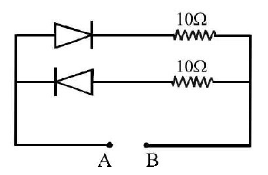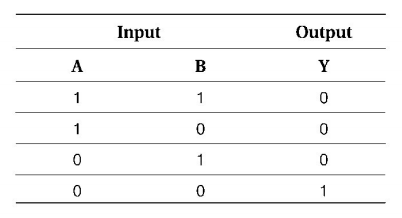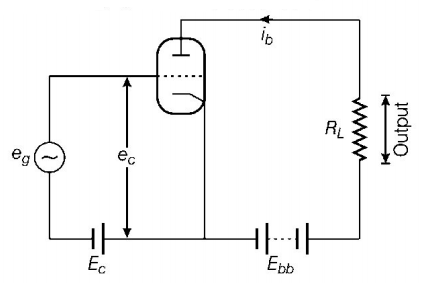1. For amplification by a triode, the signal to be amplified is given to
A
the cathode
B
the grid
C
the glass-envelope
D
the anode
Answer :
the grid
2. Diamond is very hard, because
A
it is covalent solid
B
it has large cohesive energy
C
high melting point
D
insoluble in all solvents
Answer :
it has large cohesive energy
3.
A $$2-V$$ battery is connected across the points $$A$$ and $$B$$ as shown in the figure given below. Assuming that the resistance of each diode is zero in forward bias, and infinity in reverse bias, the current supplied by the battery when its positive terminal is connected to $$A,$$ is

A
$$0.2\,A$$
B
$$0.4\,A$$
C
$$0.3\,A$$
D
$$0.1\,A$$
Answer :
$$0.2\,A$$
4. A forward biased diode is
A


B


C


D


Answer :


5. Current gain of a transistor in common base mode is 0.95. Its value in common emitter mode is
A
0.95
B
1.5
C
19
D
$${\left( {19} \right)^{ - 1}}$$
Answer :
19
6.
The following truth table belongs to which of the following four gates ?

| Inputs | Output | |
|---|---|---|
| A | B | Y |
| 1 | 1 | 0 |
| 1 | 0 | 0 |
| 0 | 1 | 0 |
| 0 | 0 | 1 |
A
NOR
B
XOR
C
NAND
D
OR
Answer :
NOR
7. An oscillator is nothing but an amplifier with
A
positive feedback
B
negative feedback
C
large gain
D
no feedback
Answer :
positive feedback
8. In a common base mode of a transistor, the collector current is $$5.488\,mA$$ for an emitter current of $$5.60\,mA.$$ The value of the base current amplification factor $$\left( \beta \right)$$ will be
A
49
B
50
C
51
D
48
Answer :
49
9. A zener diode of voltage $${V_Z}\left( { = 6V} \right)$$ is used to maintain a constant voltage across a load resistance $${R_L}\left( { = 1000\,\Omega } \right)$$ by using a series resistance $${R_S}\left( { = 100\,\Omega } \right).$$ If the e.m.f. of source is $$E\left( { = 9\,V} \right),$$ what is the power being dissipated in Zener diode ?
A
0.144 watt
B
0.324 watt
C
0.244 watt
D
0.544 watt
Answer :
0.144 watt
10. Carbon, silicon and germanium have four valence electrons each. At room temperature which one of the following statements is most appropriate ?
A
The number of free electrons for conduction is significant only in $$Si$$ and Ge but small in $$C.$$
B
The number of free conduction electrons is significant in $$C$$ but small in $$Si$$ and $$Ge.$$
C
The number of free conduction electrons is negligibly small in all the three.
D
The number of free electrons for conduction is significant in all the three.
Answer :
The number of free electrons for conduction is significant only in $$Si$$ and Ge but small in $$C.$$


